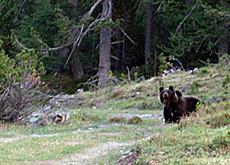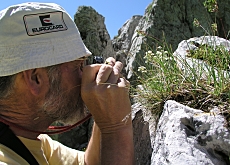Long live the “King of the Alps”

swissinfo climbs a mountain for a close encounter with the ibex, to find out why the Swiss are smitten with a species of mountain goat they once hunted into extinction.
The team of biologists I accompanied are a key link in a conservation chain ensuring that the ibex colonies spread across the Swiss Alps remain healthy – exactly 100 years after the animal’s re-introduction.
There are about 14,000 ibex in Switzerland, and about 250 of them live in the wild on the high ridge running parallel to the northern shore of Lake Brienz.
The task of the nine biologists was to conduct a count of the ibex and chamois (members of the same sub-family of cloven-hoofed bovids), co-existing on the steep slopes surrounding just one of the ridge’s peaks, the Augstmatthorn.
“It’s important to have data over a long period of time so we can say something about the dynamics of the population, for instance how it has developed over the years, the birth and death rates, and the effects of disease or a harsh winter marked by avalanches,” explains Mark Struch.
Struch is from the wildlife consultancy, WildARK. As head of the observation team he positions the other members of the group around the peak before setting out himself on the steep ascent of the 2,100-metre-high summit.
The pastures used by farmers for grazing cattle end not far above base camp. The wildlife reserve begins here. We startle a grouse into flight and – with the incessant ringing of cowbells still in our ears – spot a first herd of chamois.
This section of the mountain has been allocated to another biologist, so Struch does not bother taking out his binoculars or high-powered scope to do a count but continues along the trail.
Coat of arms
The ibex are higher up. This proud animal became extinct in the Swiss Alps in the first half of the 19th century. But a country where the ibex adorns the coat of arms of more than 50 towns and villages, and in particular that of canton Graubünden, was not willing to accept its absence for long.
The Swiss authorities finally gave poachers the green light in 1906 to cross the border into Italy to capture a few kids and return with them to Switzerland.
Raised in captivity, the successful release of ibex into the wild took place over the following decades. What was to become the Augstmatthorn colony was one of the first to establish itself, dating back to 1921.
“It’s an impressive and not very shy animal,” says Struch as we approach a herd of grazing males just below the ridge. “We can get within ten metres of it, or even closer. That’s one reason people find it more attractive than deer or chamois. It’s the king of the mountains.”
Mountain throne
If the mighty horns are its crown, the mountain is its throne. We see the next herd guarding the mountaintop, the animals’ majestic headpieces silhouetted against the lowering sun.
It is easy to experience vertigo up here. We can see the cows dotting the groomed pastures below and at our feet on the other side of the ridge, a tiny train snakes through lakeshore villages.
The existence of the ibex colonies reassure the Swiss that there is room for wildlife in a densely populated country where a disparate yet powerful lobby of dairy farmers, livestock owners and hunters claims much of the uninhabited land, even in the mountains.
A female whistles shrilly to warn others of our arrival. Females prefer to keep their distance, since it is their duty to protect the young. There is only one natural predator stalking this ridge, a lone lynx, according to Struch.
He says he would also welcome the re-introduction of the wolf in this part of the Swiss Alps, since the presence of large predatory animals would be a sign of an intact eco-system. But that is unlikely.
Wolf and bear
There was an outcry when the wolf began reappearing in other parts of the country over the past decade, forcing the government to downgrade its protection status in order to save livestock. The authorities have also published a strategy paper for dealing with the return of the brown bear.
A specimen which crossed from Italy into southeastern Switzerland last summer proved to have quite an appetite for sheep and calves, turning it from a cuddly, tourist attraction into an unwanted guest.
One would think the ibex would thrive due to the lack of natural enemies, but biologists say the Swiss population is decreasing slightly. They guess it may be the victim of disease or inbreeding.
Struch combs the Augstmatthorn slopes with his binoculars, counting the size of the herds, noting the sex and numbers of newborn and yearlings. Back at base camp, his team confirms that at the very least, the Augstmatthorn colony is standing its ground. It has a stable population of about 100 animals.
swissinfo, Dale Bechtel on the Augstmatthorn
There are around 40,000 ibex living in colonies throughout the Alps.
Switzerland is believed to have the most – around 14,000 – followed closely by Italy.
Some of the most prominent colonies in the Swiss Alps are found in the National Park in canton Graubünden, the Augstmatthorn in the Bernese Oberland and on Mont Pleureur in canton Valais.
Events are taking place across the country this year to mark the centenary of the ibex re-introduction into Switzerland.
Organised by the federal environment office, ChasseSuisse (hunters), Pro Natura, the Swiss Alpine Club and ZooSchweiz, the jubilee highlight was the symbolic return of 40 ibex to Italy in June.
It commemorated the decision by Switzerland to reintroduce the ibex illegally from Italy in 1906, after King Vittorio Emanuele II refused to sell them.
The “Third International Conference on Alpine Ibex” will take place in the mountain village of Pontresina from October 12-14.

In compliance with the JTI standards
More: SWI swissinfo.ch certified by the Journalism Trust Initiative












You can find an overview of ongoing debates with our journalists here . Please join us!
If you want to start a conversation about a topic raised in this article or want to report factual errors, email us at english@swissinfo.ch.